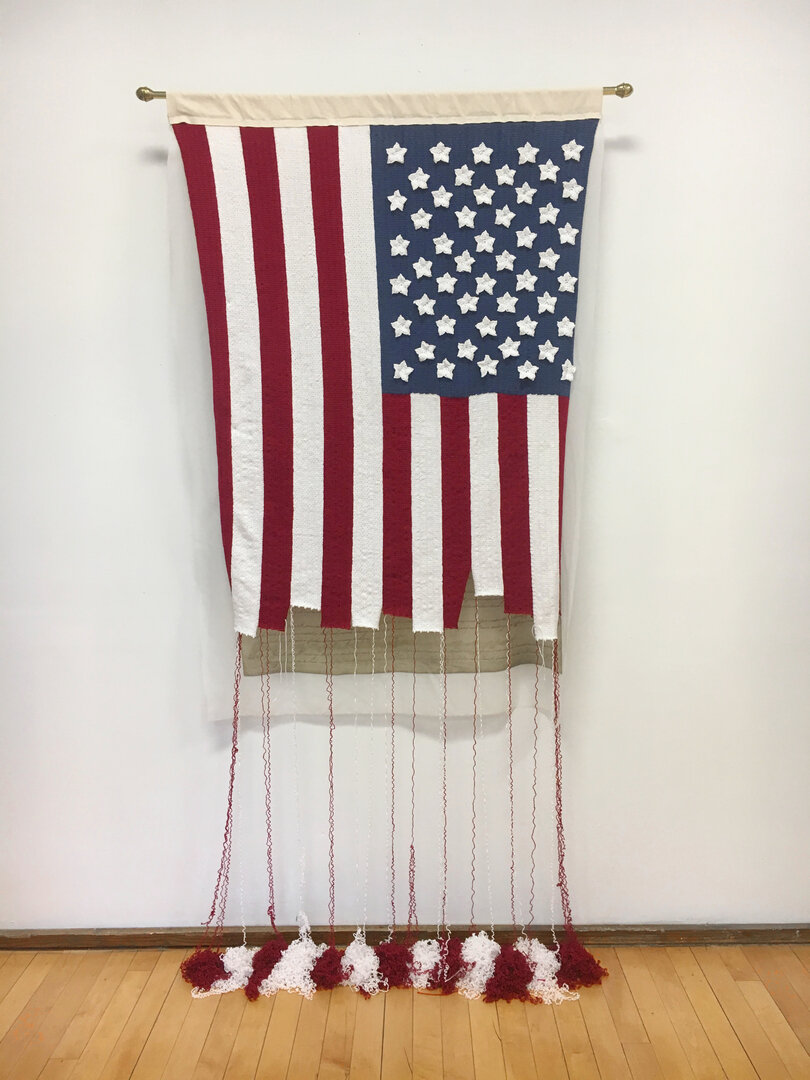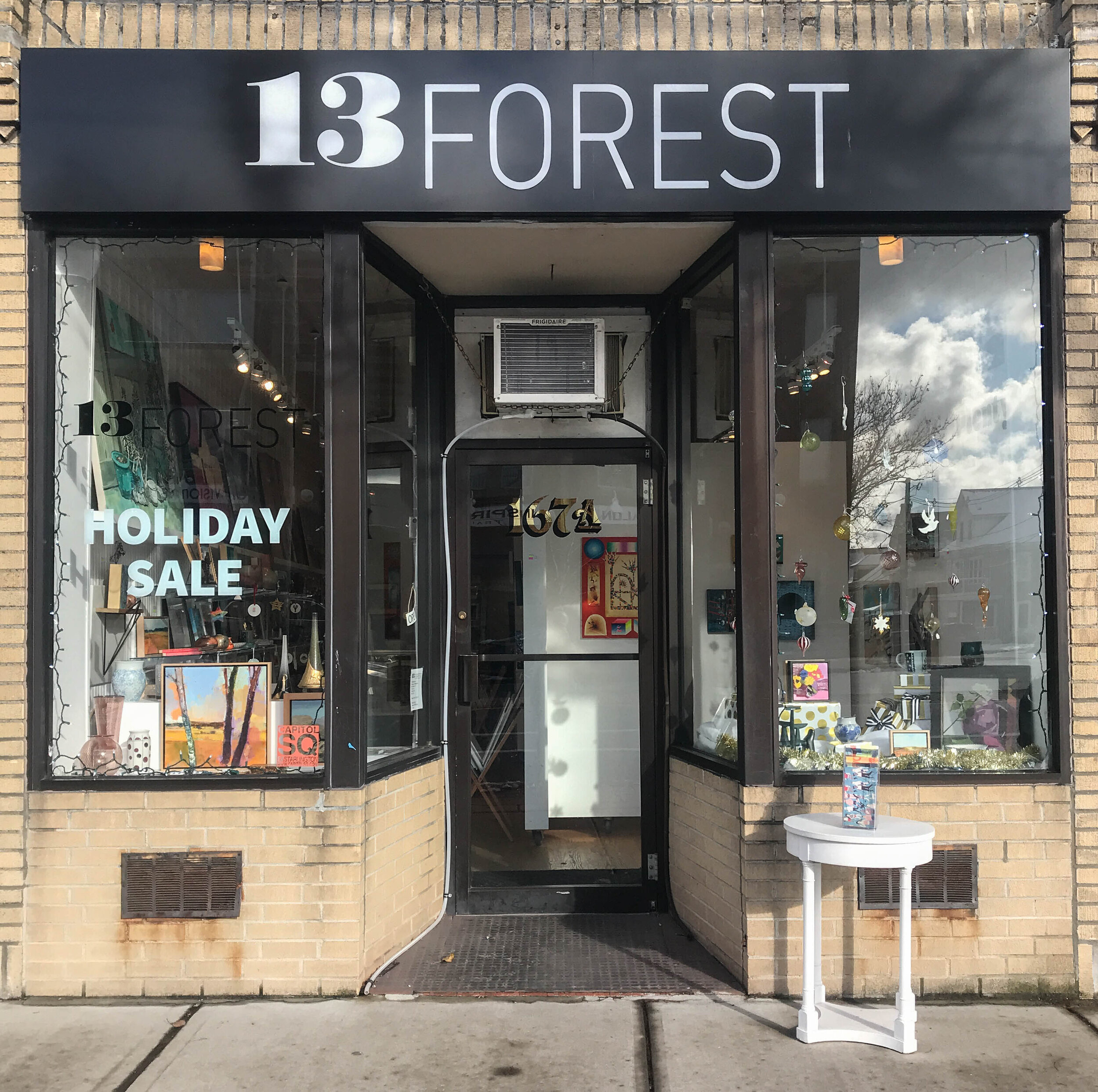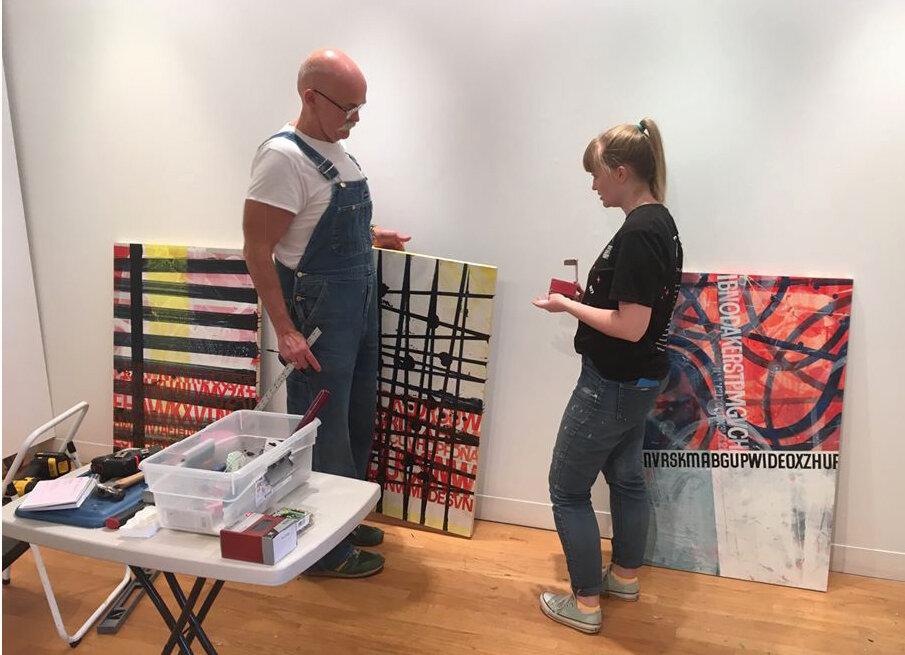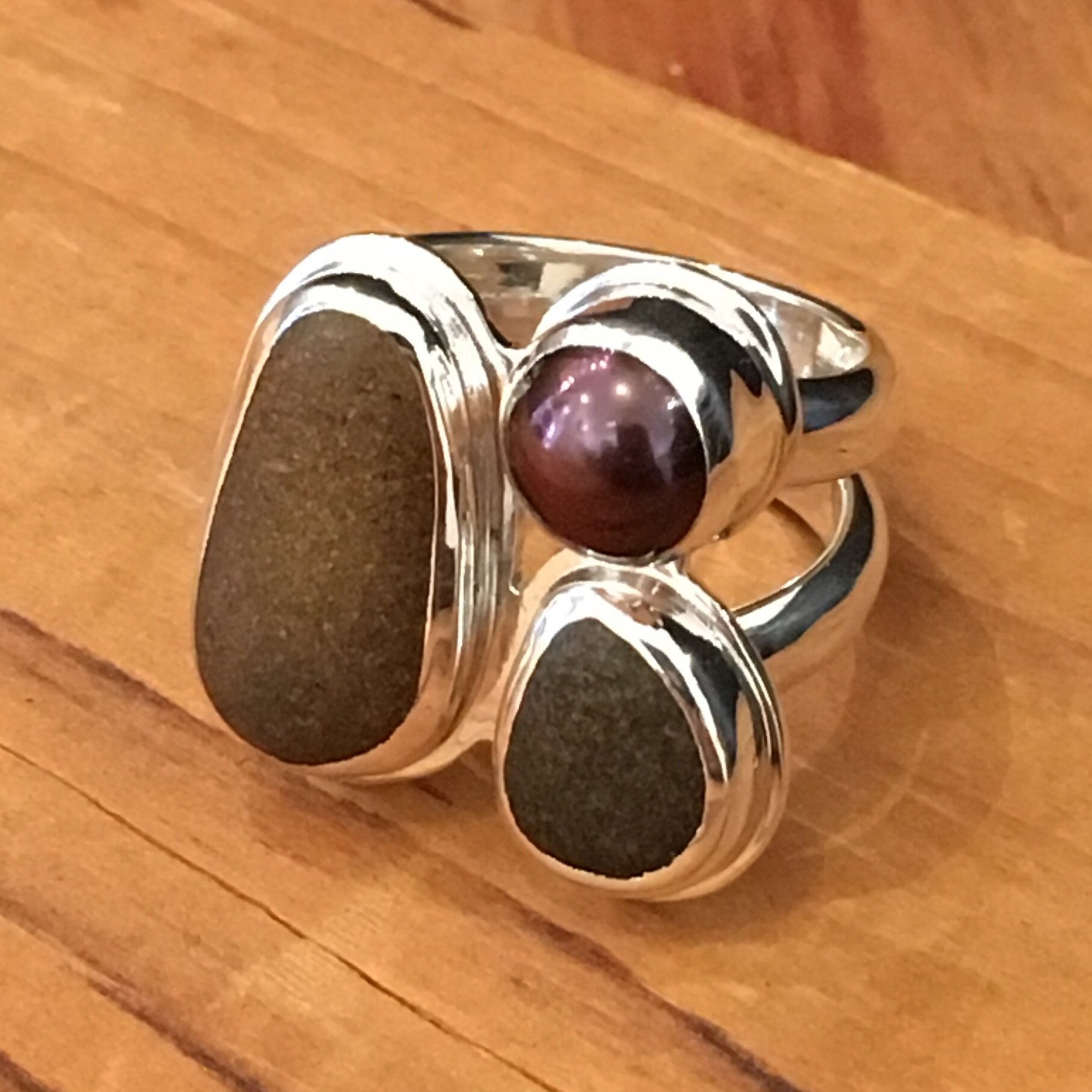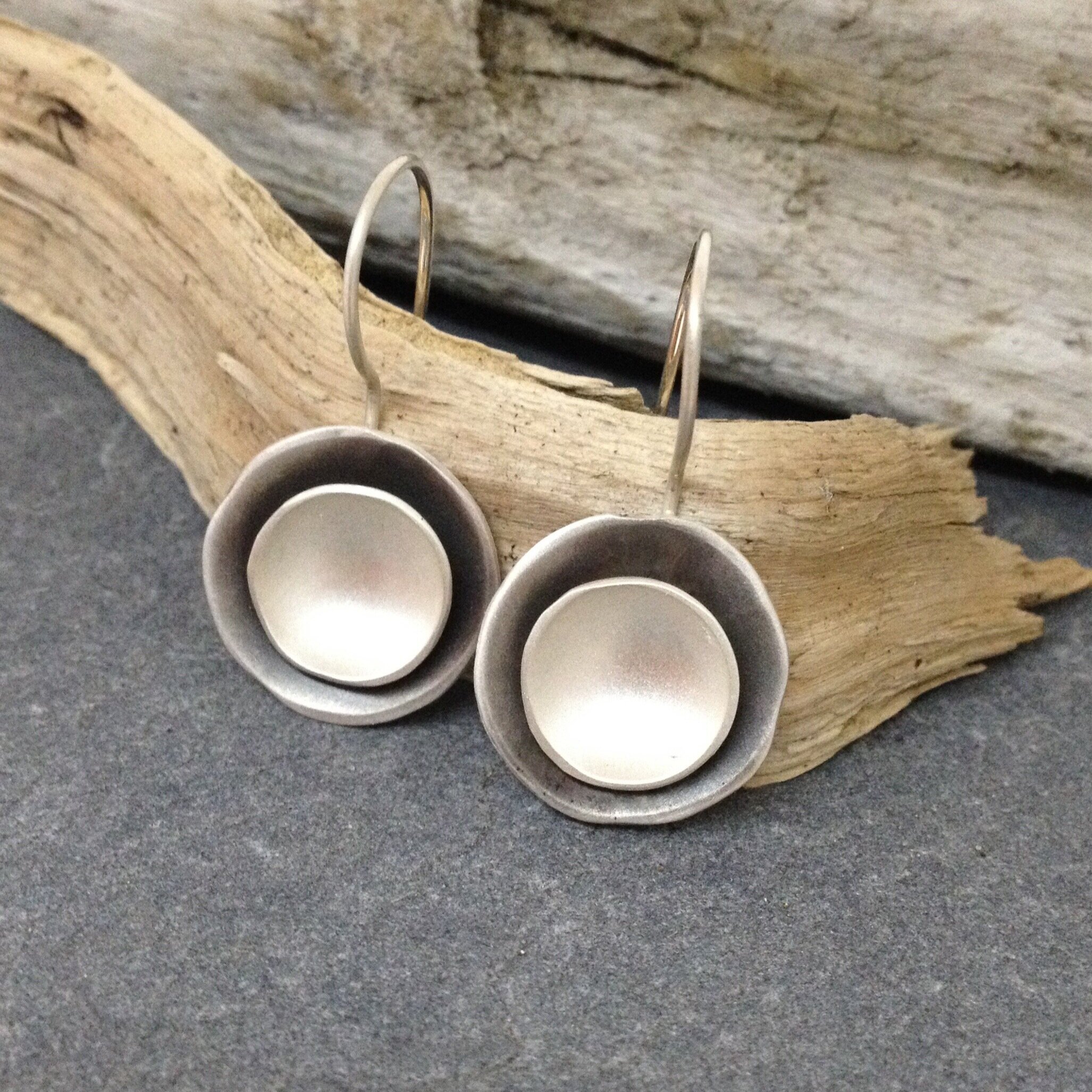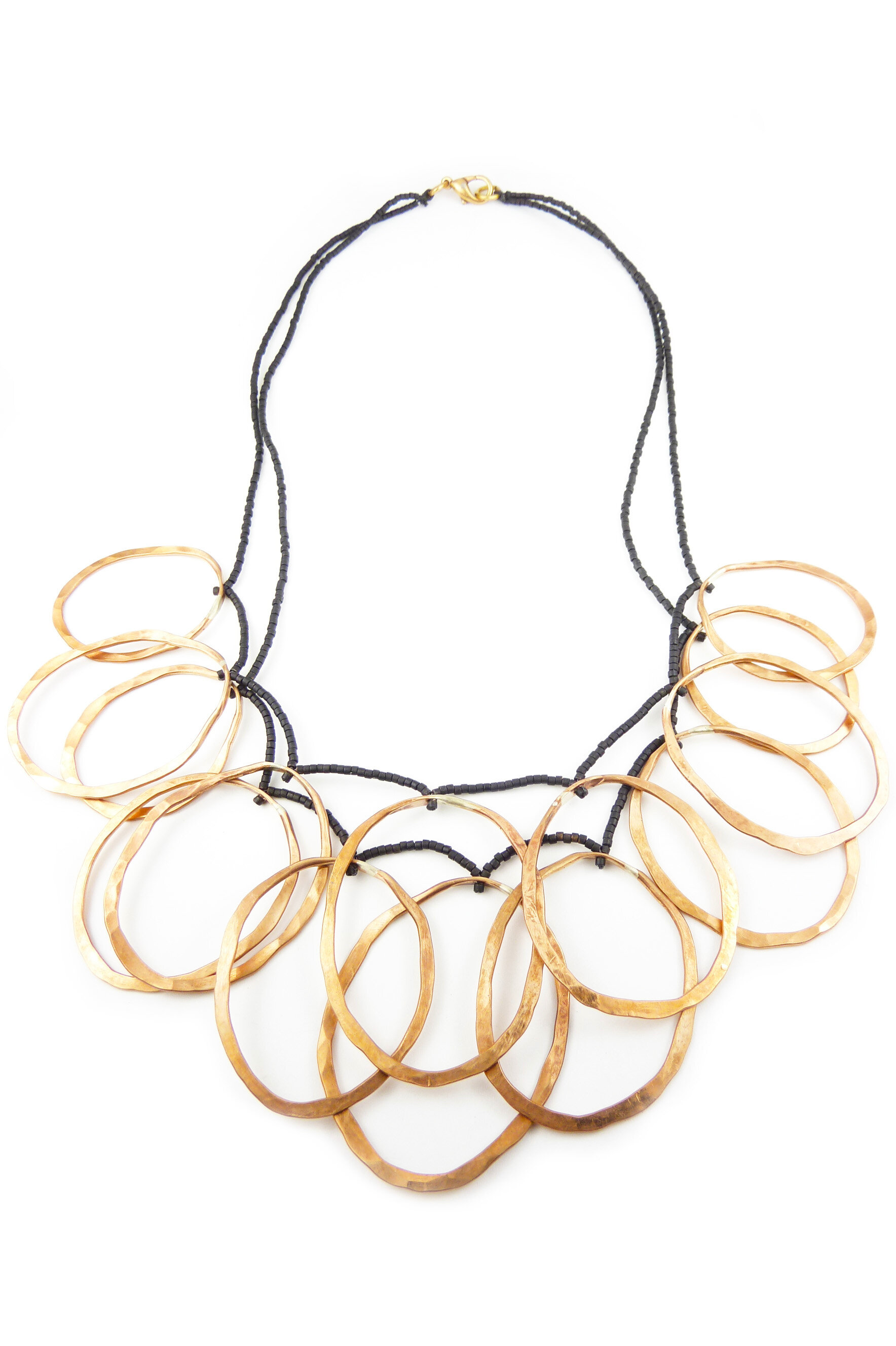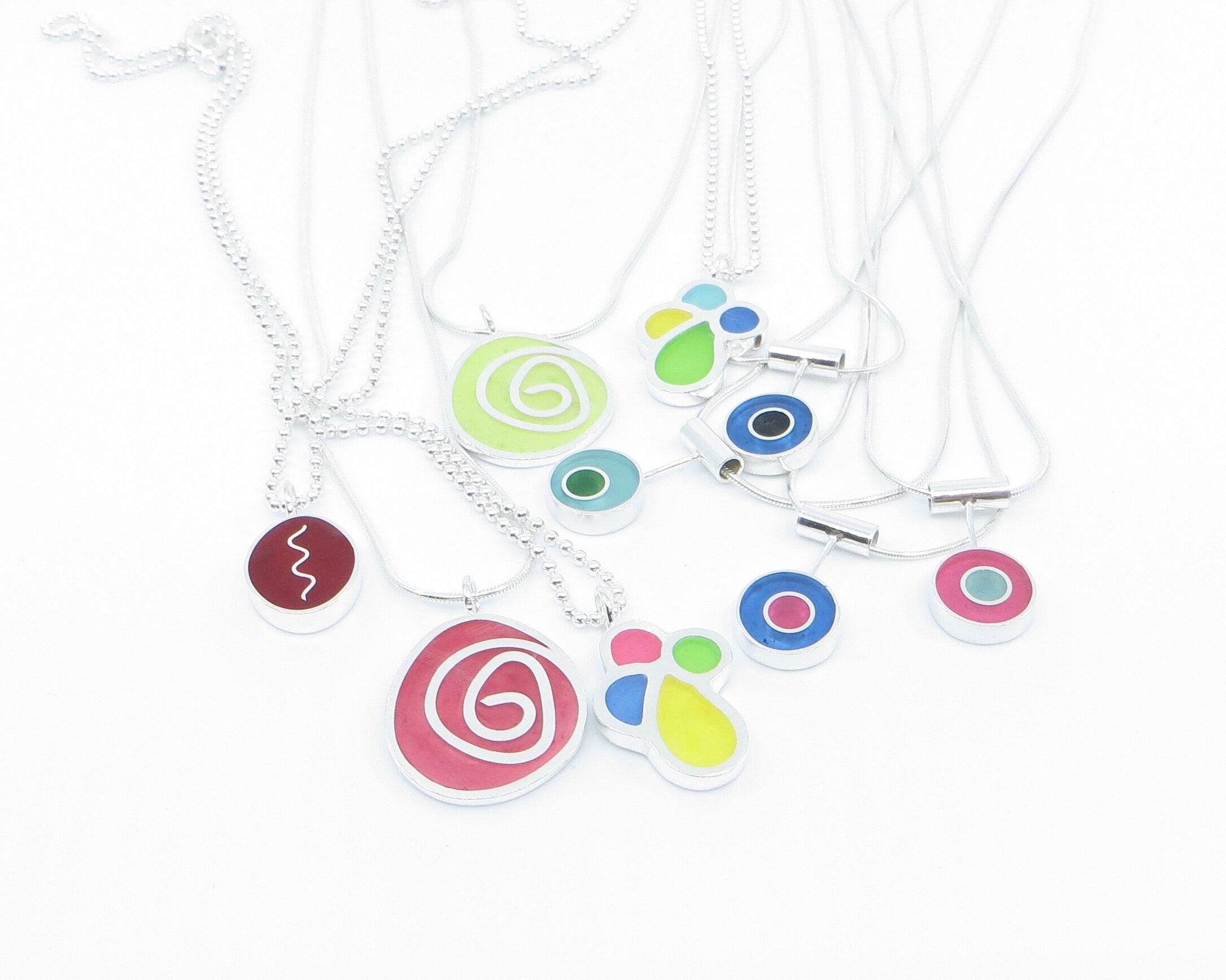As an art gallery we provide the community an opportunity to visit our physical space to connect with artists and their art. Since we can't open our doors to host our usual events right now, we've had to get a little creative in how to bring our current exhibition Panorama to the public eye.
For this show we've gone virtual by creating a video that serves as a tour of the show, an introduction to the featured artists Paul Beckingham, Lynette Haggard, and Bonita LeFlore, and an explanation of how we curated their work. We hope you enjoy this video, and make sure to check out our social media and newsletter for more digital engagement with the artists of 13FOREST.
Fascination Street - A Closer Look
Fascination Street, Mike Ryczek’s first solo exhibition, is the product of three years of intensive study, imagining and revision. Working from photographs taken on his trip to Seoul, South Korea in 2016, Ryczek collaged together imagery and incorporated research into Korean culture to create paintings that capture the sights and sensations from his first trip outside of the country. The descriptions below provide more insight into the experiences and research that inspired each painting. Read more about Ryczek and Fascination Street here.
Soft Power, oil on panel, 13" x 25" framed, $1,250
Soft Power was the first completed piece in Fascination Street and served as a way for Ryczek to test out his ideas before committing to an entire series about his experience in Seoul, South Korea. The painting juxtaposes two scenes Ryczek found in the city: graffiti on a street corner and the omnipresent cute characters seen on commercial goods, subway signs and hospitals. The friendly cartoon faces are meant to encourage cooperation, acting as a form of "soft power," or social control attained through attraction as opposed to force. Together the images contrast urban neglect with the enticing veneer of consumerism.
Decline and Fall, oil on panel, 31 1/2” x 31 1/2” framed, sold
Decline and Fall was inspired by a unintentional snapshot of an employee on a smoke break outside the entrance to the Majang Meat Market. In his research for Fascination Street, Ryczek learned about the workaholic culture in South Korea that has lead to an increase in stress-related deaths. He began to think of the figure in Decline and Fall as another victim of toxic work culture trying to steal a moment of relief. The man is dwarfed by his chaotic surroundings, which serve as an outward manifestation of inner turmoil.
Display, oil on panel, 19” x 25” framed, $1,800
Like several other paintings in Fascination Street, Display began with a quickly snapped photograph. Revisiting the image after returning from Seoul, Ryczek found the intoxicating abundance of the stalls in Mangwon Market to be a particularly rich source of inspiration. The piles of meat on display were both beautiful and repulsive, and the stall's location next to a cosmetics shop invited some intriguing comparisons. Ryczek often divides his compositions into distinct emotionally charged "compartments" to create different moods within his paintings. His challenge with Display was to contain the overwhelming detail in the scene to a series of these compartments while maintaining the original memory's movement and energy.
Nursery, oil on panel, 25” x 19” framed, $1,800
Nursery captures the frenetic energy and communal atmosphere of a restaurant in Seoul. The rushing servers, suffocating heat, steam from grilling one’s own food and array of side dishes and condiments (banchan) create a dynamic environment for the shared meal not experienced in many traditional American eateries. Ryczek was particularly struck by the sensation of eating while sitting cross-legged on the floor. Much of Ryczek's painting process involves connecting with his inner child, and his ground level perspective during the meal proved instrumental for that purpose.
Passage, oil on panel, 25” x 19” framed, sold
Passage conflates two of Ryczek's memories from his trip. The majority of the composition derives from a photograph he snapped while trying to get through a crowd of people. However in Ryczek's recreation, the bustling street is flooded with dark water. On a different trip through the city, Ryczek encountered a flooded walkway running along the Han River. Adults casually splashed through the water chatting and children stopped to play in it. Together these memories tell a story of beauty found in the commotion of a city, and of environments that disrupt that commotion and allow strangers to connect.
Gazing Girls, oil on panel, 25” x 19” framed, $1,800
Gazing Girls and its companion Passage were originally planned as a combined collage showing day fading into night, but Ryczek eventually expanded the composition into two paintings to fully capture each scene. While working on both paintings, Ryczek reflected on the question of what makes Seoul so visually distinct from other major world cities. He sought to convey the singular visual effect created by dense rows of vertical signage and neon storefronts packed into narrow alleyways. Documenting the fluorescent optical assault of Seoul's night time cityscape was essential to communicating Ryczek's brief experience there. The awe-struck stances of the titular figures perfectly express what Ryczek felt and what he wants the viewer to feel when encountering such a scene.
Apex, oil on panel, 31 3/4” x 37 3/4” framed, $3,200
Apex is centered around a statue of King Sejong the Great who ruled Korea during the Joseon Dynasty from 1419 to 1450. He is seen by most Koreans as being responsible for some of the greatest cultural achievements in Korean history, namely inventing the Korean language Hangul. The historical significance of the statue, located in a prominent place in Seoul, is heightened by Ryczek's choice to surround the figure with cityscape imagery observed during his trip to the Namsan Observation Tower (the second highest point in Seoul) and the visually weighty symmetry of the painting. The obscured face of the statue acts as a window into time, connecting past and present, and serves to question idealized fantasies of historical figures after their deaths.
Lost and Found, oil on panel, 19” x 25” framed, sold
Lost and Found started as a quiet scene taken from a tour of Gyeongbokgung Palace, a major tourist site in Seoul, and ended as a slightly surreal collage of real and imagined traditional Korean architecture. The group of figures wearing traditional Korean hanbok dresses are the only element taken from the original photograph. The surrounding composition combines royal architecture with traditional urban façades inspired by the reconstructed Bukchon Hanok Village. Ryczek added anachronistic elements like paper lanterns, stylized clouds and geometric symbols to create a sense of the past merging with the present. The title hints at a tense relationship with Japan due to two periods of Japanese occupation in South Korea. The palace, destroyed and rebuilt many times during the occupations, symbolizes resilience and restored pride for Korean people. The centralized red dot and wilted cherry blossoms hint at the stain left by these events.
Han, oil on panel, 19” x 25” framed, $1,800
Through his research for Fascination Street, Ryczek learned about han, a broad concept prevalent in contemporary Korean culture which encapsulates feelings of rage, resentment, grief and hopelessness. The central figure evokes the feeling of han with her unsettling gaze and empty bouquet. She is immersed in black water, a reference to the Han River, one of the major rivers in South Korea. Her expression is mirrored by a cartoonish cloud, a recurring image in Fascination Street, with a similar vacant stare. Contrasting the somber portrait of the woman are the images of lotus flowers, a symbol of rebirth, and a cheerful cloud; these elements offer hope for persistence through suffering.
Perilla, oil on panel, 19” x 25” framed, $1,800
The dust masks commonly worn in South Korea due to the poor air quality serve as a central symbolic element of Perilla. Wearing the masks eventually developed into a fashion statement, with many stylish options available. For Ryczek these masks represent a unique convergence of self-preservation, anonymity and self-expression. The purple perilla leaves (a common ingredient in Korean cooking) surrounding the defiant female figures act as a protective shroud and camouflage, while the grungy atmosphere of the painting creates an atmosphere of menace and hopelessness. As the painting evolved Ryczek delved into researching the fragile status of women in South Korea, and incorporated elements representative of the issues that Korean women are fighting against such as domestic violence and spy camera pornography. In 2016, the year of Ryczek's trip, South Korea also experienced the contentious impeachment of their first female president, Park Geun-hye.
Minjok, oil on panel, 31 1/2” x 31 1/2” framed, $2,700
In Minjok Ryczek employs the iconic image of a lotus flower, often a symbol of enlightenment and rebirth, in his exploration of the controversial concept of Korean identity known as minjok. The concept arose amongst Korean intellectuals during the Japanese occupation between 1910 and 1945 as a way for Koreans to distinguish themselves from their enemies and promote national unity. As modern South Korea becomes more multicultural, minjok still remains a powerful identifier. Polls have shown that Korea is more likely than most other countries to view itself as "one people" who share the same bloodline. Ryczek's composition represents the tension between a unified Korean identity and an increasingly diverse society by centering a lotus grouping that is isolated, but also merging with its surroundings.
Lesson, oil and pencil on paper, 14” x 14” framed, sold
While inside the National Museum of Korea, Ryczek observed a teacher with a small group of students gesturing toward the 38th parallel (the latitude marking the separation between North and South Korea) on a wall map. He initially planned to include the map in Lesson, but found that the political implications of the subject distracted from the quiet nature of the interaction he witnessed between teacher and student.
Level, oil on panel, 19” x 25” framed, $1,800
Level is an ode to Ryczek's own childhood nostalgia and the cuteness culture prevalent in Korea. The painting began with a photograph of the skyline taken from Ryczek's hotel room. The Jumbotron that dominated his view seemed to encapsulate the sleek, beautiful and technologically advanced image that modern Seoul tries to present to the world. The sight reminded him of skylines from Nintendo games (primarily by Japanese designers) he played as a child; Ryczek reflected on how much his preconceptions of East Asian cities were shaped by those early moments of indirect exposure. Ryczek added elements characteristic of side-scrolling games like jewels, power-ups, life meters and other 8-bit video game staples to the scene. The cloud on the Jumbotron takes its haunted expression from a toy Ryczek spotted in Kyobo Bookstore, reflecting the unique blend of dark humor and anxiety he found in many similar tokens he encountered in Seoul.
BTS, oil and pencil on mylar, 14” x 14” framed, $750
BLACKPINK, oil and pencil on mylar, 14” x 14” framed, $750
K-pop is currently the most recognizable pop culture export from South Korea. Ryczek watched a lot of K-pop videos while preparing himself for his trip, and continued enjoying them while working on Fascination Street. These portraits serve as monuments to the two most prevalent gender specific identities portrayed in the K-pop industry. BTS represents the fashion-conscious androgynous male, while BLACKPINK captures the aggressive and arrogant femme-fatale. Oil portraiture, a medium traditionally used to facilitate insight into a subject's emotional reality, was an intriguing means through which to convey the dazzling and over-stimulating style of K-pop that seems to reject deeper examination. While indulging in the shallow excess and endless visual variety of K-pop videos, Ryczek discovered a startling sensuality in the subjects he was painting.
The Unraveling - Political Performance Art by Adrienne Sloane
The Unraveling, cotton knit and polyester and cotton fabric, 2017
13FOREST Gallery is pleased to present The Unraveling, an installation by fiber artist Adrienne Sloane, on view January 18 to February 7, 2020. This temporary installation will culminate with a performance by Sloane and a reception on Sunday, February 2 from 4-6 pm.
Sloane was moved to create The Unraveling in the wake of the 2016 election, as a response to the shocking actions of the Trump administration. The installation consists of a hand-knitted American flag that hangs in front of a copy of the United States constitution printed on fabric. Sloane has been performing a series of “unravelings” since she developed the installation, slowly pulling apart her knitted flag to reveal the constitution underneath. She is committed to continue unraveling the flag in public performances until President Trump has been removed from office, or until there is no flag left. Recently featured as the centerfold in Artscope magazine, Sloane had this to say of her ongoing project:
As I listen to the news while in my studio, I often find myself responding viscerally and through my art to the political landscape of the day. Since the 2016 election, the news has been dominated by an unorthodox administration that I see as undermining our democracy, national unity and the values we stand for as Americans...Set against the backdrop of the constitution, I will continue to unravel this piece as long as I continue to see our civil and political rights eroding under the current administration.
As Congress prepares to begin the impeachment trial of President Trump, the installation of The Unraveling at 13FOREST offers a powerful opportunity to reflect on the state of our national identity. Sloane intends not only to comment on the current political climate with The Unraveling, but to challenge her viewers to take action against the forces dismantling American democracy and values. Her installation includes a postcard writing campaign designed to encourage people to contact their elected representatives. Sloane's politically engaged knitted art belongs to a long history of fiber arts and craft used in political protest and institutional critique. In an article featuring The Unraveling in WBUR's the ARTery, Society of Arts + Crafts executive director Brigitte Martin explained that "Sloane is creating fine art work that uplifts a lineage of female artists who re-situated knitting — a skill often diminished as domestic and feminine — into piercing political commentary." Craftivist Betsy Greer expands on similar ideas in her article "Crafting Understanding: Addressing Political Issues Through Stitch," which places Sloane's work in context with other politically active contemporary fiber artists.
Sloane's powerful and poignant work has been acclaimed by many arts institutions, resonating with audiences throughout New England. The Unraveling has been featured by the Society of Arts + Crafts, the Fuller Craft Museum, the New Bedford Art Museum, and the Rockland Center for the Arts in West Nyack, New York. After 13FOREST Gallery's exhibition of The Unraveling, the piece will be installed in the Massachusetts State House in Senator Will Brownsberger's office, with a public unraveling and reception on Tuesday, February 18 from 3-5 pm.
Adrienne Sloane next to The Unraveling (Courtesy Society of Arts + Crafts)
Hyman Bloom, Edgar and Me - when a security guard becomes a docent
Hyman Bloom, The Stone, oil on canvas (1947) - now on display at the Boston MFA as part of its exhibition Hyman Bloom: Matters of Life and Death
The difference between looking and seeing is that of perceiving an object and understanding it - or at least communicating with it. Some things can never be fully understood. I was reminded of this today while walking through the MFA and stopping to speak to Edgar, a Mexican immigrant who had become a museum security guard after losing his job as a butcher. He walks miles a day through the museum and today he happened to be stationed in the Hyman Bloom exhibition hall, where I spent the afternoon. Standing alone in front of Bloom's painting The Stone, I asked Edgar, "What do you think of this?"
"I hated this show and that painting when I first got here, but now they're my favorites ones."
"Why? What is it about this painting in particular?"
"A month after the show started,” Edgar replied, “I noticed that the painting looked a little like the [early] Jackson Pollock paintings hanging in the hallway. And I noticed them because they reminded me of the molas I grew up around. They look a little like the Alaskan carvings in one of the other rooms, too."
I was pretty impressed. "Pollock knew pre-Colombian art, and you're right about the mola and Alaska connections."
Edgar went on, "So I stood in front of [The Stone] and looked at it for a long time. I saw jewels and land and light in it - something alive in something that never lived. It changed how I see everything else by this artist"
"Do you think it's true, that non-living things have life?"
"Not life," he replied with a pause, "just souls."
Walking to the next painting, I said to Edgar, "I think Hyman Bloom would like that. You should be a tour guide."
He looked at me. “It would be nice to make people stop and pay attention to more things,”
Jim Kiely
Hyman Bloom: Matters of Life and Death will be running at the MFA through February 23, 2020.
MoMA Finally Finds Faith Ringgold
On January 2 a cartoon strip running atop the entire New York Times Arts & Leisure section caught my eye. Part of it alludes to a visitor conversation overheard at the Museum of Modern Art about painters Faith Ringgold and Pablo Picasso, two of whose works now hang side by side in the museum. In mildly drole fashion the strip made at least two important points: the fact that MoMA has abandoned its ism-based method of displaying art, which inherently excluded artists of color and of various ethnicity; and, in doing so, it has expanded its notions of what constitutes exceptional art and who exceptional artists are.
Faith Ringgold, American People Series #20: Die, oil on canvas, 6’ x 12’, 1967
Faith Ringgold is an 89-year-old, black American painter, fiber artist and book illustrator who in her student days studied European art history, including Cubism. In 1967 she painted American People Series #20: Die, which combines the Cubist grid of Picasso’s Guernica with her own black consciousness to present the brutality of American racism. Considered an achievement in synthesis by its contemporary reviewers, the work (like most of Ringgold’s output) was infrequently displayed because of its political content. Two generations later, MoMA, which owns this painting, has finally reconfigured itself so the destruction of Francisco Franco’s bombing raid and the destructive force of racism can both be brought to people’s attention - on an equal footing.
Pablo Picasso, Guernica, oil on canvas, 11’ 6” x 25’ 6”, 1937
In the cartoon strip, visitors make the connection between Ringgold and Picasso, even though it is the latter’s Les Demoiselles d'Avignon and not Guernica that hangs at MoMA. It indicates, perhaps, that the museum’s modernization can in fact broaden not only our collective memory of images, but also our ability to make connections between the consequences of human behavior.
Here’s a link to an interview of Faith Ringgold conducted by the Tate Modern in 2018. If you do not know of her or her work, it will serve as a first-rate introduction to both. Interview of Faith Ringgold
Left to right at MoMA: Pablo Picasso, Les Demoiselles d'Avignon, oil on canvas, 8’ x 7’ 8”, 1907; Faith Ringgold, American People Series #20: Die
Jim Kiely
13FOREST / 13 Years - celebrating the holidays and our anniversary
On Friday, December 13, 2019 from 6-8 pm we will be holding our annual holiday shindig. Adding to the festivities, we will take the occasion to celebrate our thirteenth anniversary as a gallery that presents the work of primarily Boston-area artists to the public. Everyone is invited join us for food, drink and our annual Holiday Sale, which will continue through Sunday, December 29.
Over the years artists and customers have asked questions about the gallery’s founding and mission. What does the name mean? How did you start? What’s the scope of your work? With all that in mind, I would like to take the opportunity to present a short history of 13FOREST Gallery and of how it has evolved over time.
In the beginning (2006): our first, tacked-up sign in Medford
Our storefront today, in East Arlington’s Capitol Square
In late-winter 2006, my husband Marc Gurton and I established 13FOREST Gallery shortly after he had been hired by photographer Lisa Tang Liu to serve as the accountant for her 500-square-foot Pigmentia Gallery, located at (surprise!) 13 Forest Street in Medford, Massachusetts. By the fall she decided to give up the gallery so we took over the lease with the hope that, should we be able to keep the lights on through Christmas, we could try to build a gallery business. We wanted to highlight our unusual position as the only gallery in Medford Square, so we adopted our street address as the name of our new business venture.
After two years in Medford we saw an opportunity to join an up-and-coming commercial district of East Arlington, which was soon to be named Capitol Square. After some renovations and the addition of shelving and moveable walls, what was once a dry-cleaning establishment on Mass Ave became our new home in February 2008. On February 29 (Leap Day) we opened our new gallery space with an exhibition titled Leap to celebrate both the day and the risk we had taken by moving to a new town. Will anyone come? It was a question every business owner asks before unlocking the door. That evening, people did indeed come, and in numbers so large that a line (and a party) formed outside the door.
From the start our mission of serving local artists has not changed. Today we present the work of over 100 artists, nearly two-thirds of whom are women. This includes painters, printmakers, photographers, sculptors, ceramicists, glassblowers, jewelers and fiber artists. We also open our space to musicians, singers, lecturers, filmmakers and a host of other people whose form of artistic expression is immediate and experiential. As a business we are, of course, glad when we sell artists’ works; however, we are also pleased when customers lend their observations or find joy in the work we present.
As our thirteenth anniversary has approached, people have asked about our favorite moments in the gallery. It’s a difficult question to answer, as there have been many for us and for the artists we work with. These are some of them, each representing a lot of work by many people: surviving the US economic collapse of 2009, making art publicly accessible to customers and visitors through exhibitions, conversations and commissions; winning the WGBH “Best Art Gallery in Boston” Award - twice; seeing the careers of artists expand into publications, museums, schools and universities; establishing close relationships with business associations, public-art organizations, cultural councils, museums, universities and political organizations; and, finally, orchestrating an annual pop-up gallery in Provincetown. When I think about it, the list doubles and then triples.
Larger than life: Marc featured as part of the 2016 Storefront Stories project in East Arlington
Gallery Director Caitee Hoglund and me hanging new work by Kenji Nakayama
Running 13FOREST Gallery has made us aware of the immense amount of artistic talent in the Boston area. Our only regret about the gallery is that it’s not large enough for us to put more of it on display. The artists with whom we do work are intelligent, open to new ideas and dedicated to communicating them through the means they know best. They amaze us with the constantly shifting expressive paths they choose to forge. All of this commands our respect and over time it has led us to form great friendships with our community of artists and the wider artistic community of which they are a part. Our mission has complexity, but above all else it is an intellectually and emotionally joyful endeavor. It becomes even more so when, standing in the gallery, customers come upon artworks that resonate with them even if it’s for reasons they cannot fully explain.
If you’re reading this article, you are part of the reason that 13FOREST Gallery has been a success. To bring this full circle, therefore, let us invite you once again to our holiday party. We couldn't have made it here without you.
Peace and the happiest of new years to you.
Jim Kiely
Gallery storefront during our annual pop-up in Provincetown at 444 Commercial Street
Accessory 2019
This holiday season we are excited to bring back Accessory, a trunk show featuring new work from our talented group of jewelers. Join us from 12-4 pm on Sunday 12/8 for a mimosa, a chance to meet the artists behind our fantastic jewelry collection, and of course some unique holiday gift shopping!
Last year’s event was great fun, and this year will be another perfect opportunity to treat yourself or someone special in your life. And don't forget, all jewelry is 10% off as part of our Holiday Sale.
Meet the Artists
Landscapes revisited - Jackson Pollock and Katharina Grosse at the MFA
Foreground: Katharina Grosse, Untitled, 2019 (acrylic paint on fabric) - Background: Jackson Pollock, Mural, 1943 (oil paint and milk paint on canvas)
At the MFA through February 23, 2020 is a two-painting exhibition titled Mural: Jackson Pollock | Katharina Grosse. Pollock's work is the 1943 masterpiece Mural, an 8' x 20' oil-and-milk-paint canvas that Peggy Guggenheim had commissioned him to create for the hallway of her apartment in Manhattan while he was still an unknown janitor. The painting filled an entire wall there until Guggenheim relocated to Venice in 1947 and donated the work to the University of Iowa. German painter Katharina Grosse's 2019 work Untitled is a 16' x 48' acrylic-on-fabric installation commissioned by the MFA. Like flowing stained glass, its mass hangs from the museum gallery's ceiling and drapes onto its floor. Notably, the work can be viewed from front and back.
The MFA was brilliant in hanging the two paintings in one gallery, but not for the reason suggested by the show's title. Neither work is a mural, which is a painting applied directly to a wall; neither is some "anti-mural" statement despite suggestions made by the museum’s wall text and video; and neither tackles the issues of permanent placement. What Mural and Untitled do have in common, however, are that they are grandly gestural and coexist within the vernacular of landscape painting. Rather than centering the show around a misplaced thematic concept, the MFA might have done better by focusing on how two such dissimilar paintings can be experienced as landscapes. It would have decoupled the works from each other but done nothing to de-legitimize their being the basis for an exhibition. Since the museum did not do that, I will with the intention of encouraging people to view the extraordinary paintings for themselves.
Jackson Pollock, Canvas, 1943 (oil paint and milk paint on canvas) - 6’ 8” x 19' 10"
It is futile to try to reckon with art entirely by pondering why an artist has created a specific image; art is ambiguous and its creators’ minds are too complex for us to draw comprehensive relationships between them. When we try, we might find some connections, but they can only partially inform our experience of what is in front of us. The rest is up to us. Such is the case with Jackson Pollock, a man of great emotion and intellect who absorbed theosophy, Wassily Kandinsky’s spiritual writings and Jungian theory. In interviews he frequently discussed North American indigenous shamanism and the belief of Pacific Northwest Indians that spirits animate everything in nature. Pollock, who maintained that he would enter trance states while painting, considered the physical world a veil that concealed an enduring, force – or set of forces – permeating everything. He could not fully represent this invisible realm, but he was a master of orienting us toward it. His paintings from the mid-1940s onward are open-ended invitations for us to reconsider what is real. That journey remains our own.
Mural lifted Pollock out of obscurity because it was commissioned by Peggy Guggenheim, who was a well-known art collector and insatiable socialite. Looking at the painting, we should bear in mind that it originally hung only a few inches off the floor and that Pollock had intended it to be seen up close, for Guggenheim’s entry hall was only 13' wide. Serving as a vertical framework is a procession of stick figures that would have stood on about the same plane as visitors to Guggenheim’s apartment. The procession anchors Mural in the genre of landscape painting; and the land they inhabit is one of emergence and disappearance. Here thickets, eddies and ribbons of paint briefly settle into letters, biomorphic forms and disembodied faces that rise and fade as we walk the painting’s length. These combined details suggest a space in which time, generation and spirits are perpetual and entwined. In that respect Mural befit the nature of Peggy Guggenheim’s home where, through circumstances of wealth and war, expatriates, artists and intellectuals converged to drink, commingle thoughts and then disburse – one day after the next.
Today the artist, his patron and members of her circle are gone. Mural, however, has outlived the specifics of its origin and placement. From the confines of museum walls, it still points in the direction of something essential.
Katharina Grosse, Untitled, 2019 (acrylic paint on fabric) - detail
Grosse's painting Untitled is differently and equally engaging. By using a permeable fabric and thin spray paint, she could compose on one side of the work and let a reverse image bleed through to the other side. From there Grosse applied more paint - apparently to both sides - without a bleed. The artist is a master of her materials and this was no aesthetic gimmick. The difference between the painting’s two sides is more than a reversal of image; it is also an energetic reversal of place. Seen from the front, Untitled reads as a landscape, where flora, geology and shafts of light converge as they might in forests and on mountainsides. On its reverse, color and complexity remain but there is more empty space, out of which emerge suggestions of urban structures and roadway interchanges, of sound and movement. In this work Grosse performs the remarkable feat of presenting two versions of the world we inhabit, each imbued with its own sense of place and purpose. Walk slowly around Untitled and you will feel part of a binary environment much bigger than yourself.
When you have an hour or two, pay a visit to Mural: Jackson Pollock | Katharina Grosse. The MFA deserves praise for presenting the artists’ works side by side. Nonetheless, my suggestion would be that, once there, you move beyond the show’s title and much of the its explanatory material. Neither sheds light on what is in front of you. Try this instead. Walk the gallery mindfully and know that, like three-dimensional landscapes, the multifaceted nature of these paintings can produce moments of wonder and knowing.
Jim Kiely
In the Path of the Stones - Arlington International Film Festival
On Saturday November 9 from 4-6 pm, 13FOREST Gallery is pleased to host a post-screening reception for the US premier of the film In the Path of the Stones, as a part of the Arlington International Film Festival. After a screening of the film at the Capitol Theater at 2:30 pm, we will be joined by the director of the documentary, Marco Antonio Pereira, for refreshments and a Q&A at 13FOREST.
In the Path of the Stones/No Caminho das Pedras
This mosaic of stories was created to honor the 450th year of Rio de Janeiro and to celebrate its process of urbanization. The film chronicles the rich history of the famous sidewalks made of Portuguese stones, since their appearance in Lisbon in the mid-19th century to their arrival in Rio de Janeiro, revealing the art, referencing the cultures and the omnipresence of the stones under the Carioca’s and Portuguese’s feet. The film includes the participation of musicians, poets and visual artists from Brazil and Portugal who were inspired by the works of art. Watch the trailer here.
About the Director
Born in Cordisburgo, Brazil, Marco Antonio Pereira is a film director, illustrator, publisher, music producer and guitarist. He has a degree in journalism and also studied film at the Escola Livre de Cinema in Belo Horizonte. Pereira founded the Arte e Vocação social project, a series of mobile film workshops held throughout Brazil. His short film A retirada para um coração bruto has screened at festivals around the world.
Outside|In 2019
13FOREST Gallery is pleased to present our third annual Outside|In event highlighting public art around Arlington. In collaboration with the Arlington Commission for Arts and Culture and Arlington Public Art, this year we are excited to host artists Freedom Baird, Michelle Lougee and Katherine Shozawa. Please join us on Friday, October 18 from 6-8 pm for a reception and discussion with the artists. The reception will start at 6 pm, the talk at 6:15 pm.
Freedom Baird's installation Room to Grow was set just off the Minuteman Bikeway near Spy Pond during the summer, and was part of the PATHWAYS project to bring contemporary art to the bike path. Room to Grow featured reclaimed furniture that Baird arranged like a bedroom. She filled the room with native plants that grew over time and took over the space she created, encouraging the viewer to think about the relationship between man-made and natural habitats.
Michelle Lougee has been appointed to a year-long residency for the town of Arlington. Lougee will work with the community through the Crochet Collaborative to create a large-scale outdoor sculpture that will be placed along the Minuteman Bikeway as a part of PATHWAYS. Lougee crochets colorful, organic-looking structures out of recycled single use plastic bags to call attention to the deadly impact that plastic waste has on the health of the environment.
Katherine Shozawa heads up the Vita Project, a participatory public artwork that explores cultural vitality as a form of physical fitness. Through interactive sculpture and performative prompts, the Vita Project invites the public to experience an inventive reinterpretation of the existing Vita Course — a series of Swiss exercise stations, also known as “parcours,” dating from 1968. These fitness courses were once adapted for parks throughout the United States; the remains of Arlington’s Vita Course winds along walking trails in historic Menotomy Rocks Park.


